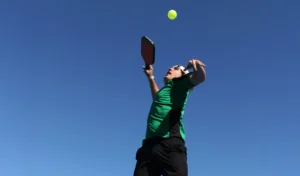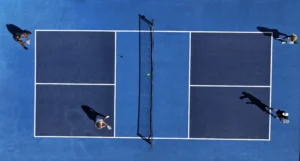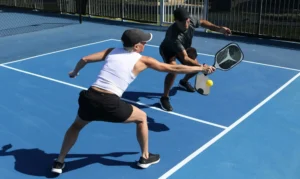
Return of serve in pickleball looks simple but is the most crucial shot in the game. A strong return sets up the rally for victory and keeps you in control while preventing the opponent from counterattacking. Whether you are a beginner, a seasoned player, or somewhere in between and looking to learn how to return a serve in pickleball effectively, this article is all you’ll need to determine how to return a perfect serve in pickleball successfully.
Why the Pickleball Serve Return Matters?
Return of serve in pickleball is not just hitting the ball over the net—it’s hitting the ball in a position to take over the rally. Since the serving team only scores, your job as the receiver is to take away their advantage and not allow them to establish a good third shot.
A Good Return of Serve Can:
- Place your opponent on the back foot.
- Give you time to transition to the kitchen line (non-volley zone).
- Reduce the chance of a good third-shot drive by your opponent.
- Keep the rally in your favor from the start.
1. What is the Double Bounce Rule?
We first have to think about the double bounce rule in pickleball before we proceed to the return strategy.
- The serve must land in the diagonal service box.
- The return must rebound before you can hit it—no return volleys.
- The serving team should also allow the return to bounce before serving again.
This is the rule that makes a good return worth so much—since your opponents cannot hit the ball in the air, you get to dictate the pace of the game.
2. Positioning for a Good Return
Even before you receive the serve, where you are is key. This is where you should be standing and how to stand ready:
Stand Behind the Baseline:
- Always stand 1-2 feet behind the baseline when serving.
- This gives you space to move in and not get caught out by a powerful serve.
Lighten Up Your Feet:
- Bend your knees and remain in an athletic position to react immediately.
- Keep the paddle ahead of you, poised to make a smooth retrieval.
Expect the Serve:
- Watch your opponent’s paddle angle and body position—it can indicate where the serve is going.
- Be prepared to change your position in a rush if necessary.
3. How to Perform the Ideal Return of Serve
Now that you’re in place let’s talk about hitting the return. These are the primary steps:
Hit the Return Deep
- Take a deep return, if possible, to your opponent’s baseline.
- A deep return has the serving side remain at the rear of the court, delaying their move up to the kitchen line (where points usually are scored).
Use a Smooth, Controlled Stroke
- Don’t strike it so hard—a controlled shot in the correct position is preferable to a hard one.
- Make a low-to-high movement to lift the ball and establish depth.
Choose the correct type of shot
- Deep Drive Return:
- A quick, penetrating return can place your opponent in a defensive mode.
- Performs best on slow or high serves.
- High & Lofted Return (Lob Return):
- A larger return gives you more time to get to the kitchen line before your opponent notices their third shot.
- Holds up well against aggressive servers who like to push forward.
- Soft & Low Return:
- A controlled, low shot makes opponents go on the defensive or neutral.
- Helps to create a more straightforward rally rather than a rapid exchange.
- Deep Drive Return:
4. Advancing to the Kitchen Line
After you’ve served your return, don’t fret—get to the non-volley zone!
- A good return gives you time to reach the kitchen, and you are well-placed to take the rally.
- Don’t rush—move in small steps while keeping an eye on the opponent’s shot.
- If your backhand return is not deep and your opponent is going to play a powerful third shot, stay back and ready to defend.
5. Common Mistakes on Returning a Serve
Even experienced players sometimes get incorrect returns on serve. A few things to be aware of are:
- Too Short Return – A short return allows your opponent to play a powerful third shot and get the upper hand. Always return deep!
- Hitting Too Hard – Power is not always more substantial. A well-placed, controlled return is more potent than a loose, hard one.
- Standing Too Close to the Baseline – If you stand too close to the baseline, you might struggle with deep serves. Make sure to leave some space to step into the shot.
- Not Moving to the Kitchen Line – You’re behind if you stay back. The best pickleball players always attempt to control the net.
6. Advanced Return of Serve Strategies
If you wish to advance your abilities, experiment using these more advanced return methods:
- Target the Weaker Opponent: Aim your pickleball serve return toward the opponent with a weaker backhand in doubles. Most players struggle with the backhand shots so that it will increase the chances of an error. Placing your return strategically can force mistakes and give your team an early advantage in the rally. Stay observant and adjust your returns based on your opponents’ weaknesses!
- Hit to the Middle: Hitting down the middle will create uncertainty among your opponents and be likely to make them hesitate or miscommunicate. This simple strategy increases the likelihood of an error and keeps your return safe while still maintaining control of the rally.
- Mix Up Your Returns: Be Unpredictable! Interleave deep shots, soft lobs, and low drives to mix up your pickleball serve returns. This confuses your opponents, making it more difficult for them to anticipate your next shot and set up for an aggressive third shot. Mix up your returns depending on your opponent’s position and weakness!
Common Faqs About Returning a Serve in Pickleball
How do I best return a serve in pickleball?
The best return is strategic, controlled, and deep. Attack the opponent’s baseline so that they have no opportunity to attack early in the rally.
Must I always return the serve deep?
Yes! A deep return prevents the serving team from reaching the kitchen too early, giving you time to move forward.
Can I volley the return of serve?
No—pickleball double bounce rule requires you to return to bounce before you hit it.
What is a dink return?
A dink return is a weak attack to the kitchen, but typically dangerous as a return of serve. It is safer to employ dinks after the rally has been established.
Or do I strike my opponent’s forehand or backhand?
Most individuals’ backhand is weaker, and thus hitting it can lead to errors. But alternate your returns so that you are unpredictable.
What can I do if my opponent is serving well?
If your opponent serves you a difficult one, try to remain calm and employ an effective stroke. Allow the ball’s power to look after itself, and look for a controlled deep return rather than attempting to overwhelm the serve.
How do I return a short serve?
For short serves, get into position rapidly and hit it deep with a soft controlled shot. Avoid hitting it hard, as this could leave the opponent with a simple third-shot opportunity.
Do I come back with topspin or slice?
A topspin return will make the ball drop low and deeper, and a slice return will skid and stay low, which will be tough on your opponent. Both are great options—give them a try and see what you prefer for your game.
How can I avoid hitting my return too high?
Use a slightly closed paddle angle and try to use a low-to-high smooth swing. Hitting too hard or slicing will cause the ball to pop up and provide your opponent with a very easy shot.
What if I struggle with deep returns?
Practice managing your power and target aiming near your opponent’s baseline. Taking your time on your swing rather than rushing the shot can aid in achieving depth control.
Do I want to play a slow or a fast return?
It’s your game! A sharp return can hurry your opponent along, and a softer lofted return gives you additional time to reach the kitchen. Blending both together can leave your opponents uncertain.
Am I able to lob my return serve?
Yes, but strategically. A penetrating, high percentage return can push the opponent back and give you time to come up. But don’t loft the ball too much, as an attacking opponent will be able to smash it.
How do I become more consistent on returns of serve?
Practice serving returns at different depths and angles. Try drills where you replicate hitting to precise spots, i.e., crosscourt corners or deep middle. Include accuracy and placement.
What is the best return strategy in doubles play?
In doubles, a deep return down the center can be disorienting to opponents, and hitting the weaker player’s backhand is usually a good strategy.
How do I make adjustments for coming back to playing outside in the wind?
When the wind is against you, hit deeper and more topspin so that the ball stays low. When the wind is behind you, hit a soft backhand so that the ball does not go long.
How do I return if my opponent serves with high spin?
Anticipate the spin early and make a paddle angle adjustment. For topspin serves, hold the paddle slightly closed. For slice or side-spin serves, shift your position and follow through smoothly to neutralize the curve.
Do I return the return crosscourt or down the line?
Crosscourt returns offer more room and keep the ball in play longer and are thus safer. Down-the-line returns can be useful but are risky, as they shorten the time the opponent reacts.
How can I employ my footwork to improve my return of serve?
Always be light on your feet, split-step off the return of serve, and be in position before you swing. Good footwork carries over into better shot control and balance.
How do I take a serve with pressure?
Breathe, relax, and go for a smooth stroke. If you feel nervous, take a high-percentage shot (deep and crosscourt) instead of trying to take a risky return.
What is the most frequent mistake players make when serving back?
The most frequent error is short-receiving, which gives the receiving team dominance. Always go deep, even when you need to cut back your shot.
Final Tip
The skill of dominating the return of serve is less about power and more about placement, consistency, and a master plan. Whether you are facing a challenging server or looking to take over the rally, these techniques will surely help you confidently return serves and produce more winning points!


